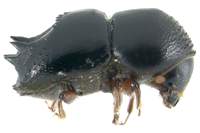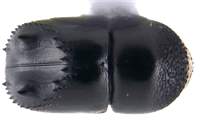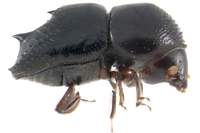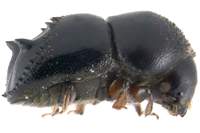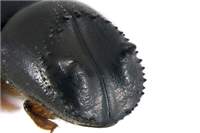Diagnosis
The most robust genus in South America, Taurodemus is easily recognized by the widely separated procoxae, by a stout body, antennal club type 1, by a broad declivity often surrounded by numerous denticles and elevated sulcus, and often with at least one large pair of spines. Protibiae bear small and numerous (9-12) socketed teeth.
Distribution
Species are uncommon, from Mexico to Brazil.
Biology
Often collected from small stems and branches (3-15 cm) in secondary forest and disturbed areas alongside roads. Species are true xylomycetophages, where larvae are reared within a communal chamber and feed on xylem during gallery expansion.
Taxonomy
Monophyletic (Hulcr et al. 2007). Although it closely resembles robust Palaeotropical forms with mesonotal mycangium (Anisandrus, Cnestus, etc.), it does not have mesonotal mycangium, and is probably not closley related. Prior to the designation of the genus, most species were placed in Xyleborus.
Detailed description
Eyes shallowly emarginated, upper portion of eyes smaller than the lower part. Antennal club approximately circular, club type one (truncated, first segment encircles the anterior face). Segment 1 of club circular around the club, concave frontally, covering the entire posterior face, its margin clearly costate around the antenna. Segment 2 of club partly corneous, visible on the anterior side only. Segment 3 of club absent on the posterior side of club. Segment 1 shorter than to pedicel, funicle 4-segmented. Scapus regularly thick. Frons above epistoma mostly smooth, alutaceous, with minor punctures. Submentum deeply impressed, shaped as a narrow triangle. Anterior edge of pronotum with a distinct row of serrations. Pronotum from lateral view robust, subquadrate or rounded (type 5). From dorsal view, rounded (type 1). Pronotal disc shining or smoothly alutaceous, with small punctures, lateral edge of pronotum obliquely costate. Procoxae narrowly separated, prosternal posterocoxal process bulging. Tuft on pronotal basis associated with mesonotal mycangium absent, setae on elytral bases associated with elytral mycangium also absent. Scutellum flat, flush with elytra. Elytral bases straight, with oblique edge, elytral short compared to the declivity and sometimes convex, punctures on elytral disc in strial lines (which may be difficult to discern). Boundary between elytral disc and declivity distinct. Lateral profile of elytral declivity rounded but steep, especially towards the apex or excavated, dorsal profile of elytral apex rounded, convex apically and not broadened laterally. Elytral declivity devoid of pubescence on impressed area. Posterolateral declivital costa clearly visible but not extending beyond the seventh interstriae (usually less than half the declivital length. Surface of declivity devoid of tubercles or tubercles on interstria 3. First interstriae parallel (sometimes slightly broadened towards elytral summit) or parallel on disc but broadened towards the apex of elytra, where it sometimes bears tubercles. Striae and interstria on the upper part of declivity even, flush with the surface or bearing teeth around the declivity. Protibia with evenly rounded edge. Posterior side of protibia flat, with setae only. Protibial denticles small, bases of denticles not enlarged, protibial margin rounded, more than 8 protibial denticles present. Metatibia of normal size. Color uniformly black (pronotum sometimes slightly lighter) or rarely with pronotum much lighter (yellow or orange) than elytra. Length: 2.4 4.5 mm.

